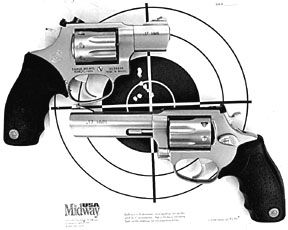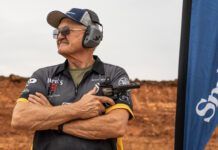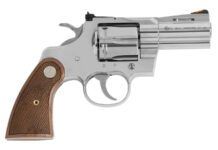
This article marks the third time we have evaluated revolvers chambered for .17 Hornady Magnum Rifle cartridge, otherwise known as the .17 HMR. The .17 HMR round features a lightweight projectile that encounters little wind resistance, making it possible to retain much of its velocity in flight. Its pointed shape also provides excellent penetration. For many hunters who favor rimfire cartridges, the .17 HMR is tops. That is probably why the first wave of available .17 HMR revolvers we tested was fit with long barrels.
But the subjects of this test are unique compact wheelguns from Taurus, the model 2-170029 and the model 2-170049. Each gun is built on a smaller frame than the Taurus Tracker M17 we tested previously. They feature barrel lengths of 2 and 4 inches respectively, typical of defensive sidearm. Naturally, we wanted to find out if these guns could serve as personal defense weapons or as handy guns for snakes and rodents. However, our experience with .17 HMR revolvers up to now has not been altogether pleasant, especially with the double-action models. Double actions we’ve tested have exhibited cylinder bind, interrupting rotation. Our best guess as to the source of this problem was case setback. That is, upon recoil the cases were moving backward out of each chamber and rubbing against the breech face.
So, naturally, we felt the results of this test would depend primarily on the ability of these guns to provide reliable double action fire. As before, we were disappointed.
[PDFCAP(1)]
Taurus International, located in Miami, imports revolvers, pistols and a line of pump-action and semi-automatic rimfire rifles from its factory in Brazil. The Taurus product lineup reflects an imaginative selection ranging from .17 HMR to .480 Ruger and .454 Casull.
However, we couldn’t find the 2-170029 on the www.Taurususa.comwebsite. The closest model to our test gun was called the 17CSS2. This gun seemed to fit the description of our test gun, but the box code reference number was different. In both cases, however, the gun was a small-frame revolver the same size as the Taurus 85 series. It had a stainless-steel frame and 2-inch barrel with shrouded ejector rod. The rod was capped and did not take part in lockup, but the crane was fixed with a spring-loaded detent pin. The cylinder latch was contoured to leave more room for loading and unloading. The rubber grip had a pebble finish and finger grooves. The front sight was ramped and serrated except for the portion of the sight that consisted of an orange plastic insert. We found that this sight reflected too much light, and we sprayed it with Hoppe’s sight black for our test session. The rear unit was fully adjustable for windage and elevation, with the notch outlined in white. The hammer could be locked from moving back by a key-operated pop up block, for which two keys were provided. The eight-chamber cylinder was fluted, and rotation was counter-clockwise. This means the next shot will come from the 1 o’clock position.
The grip was comfortable, and the gun offered a natural index. The single-action trigger was smooth, but the double action was rather heavy at 16+ pounds. Due to the trigger’s smooth, predictable action, we nonetheless found it easy to have the sights aligned by the time the shot broke.
However, the first time we fired the gun the cylinder began to bind. Cleaning the cylinders did not seem to help the gun cycle freely. With so few shots having been fired, we ruled out any type of expansion due to heat as an explanation for the cylinder bind. Additionally, releasing the cylinder required a great deal of force, and the empty cases had to be pried from each chamber. In fact, both the Smith & Wesson M17 and the Taurus Tracker tested in the October 2003 issue suffered varying degrees of this same problem. We’re not sure if the problem of adapting tapered cases to the double-action revolver will ever be solved.
But we did find some evidence that Taurus may have tried to address this issue by changing the inner dimension of the chambers. Upon ejection we noticed that the profiles of the spent cases were greatly deformed from the point of taper forward. Naturally, we would expect the case mouths to be expanded but the degree to which the bottleneck had been straightened caused a good many to be split open. Perhaps Taurus had bored the chambers deeper? This could result in a lack of support and explain why the rims of the spent cases burst.
To avoid cylinder bind during [PDFCAP(2)], we chose to fire single-action only. Loading five rounds at a time reduced the incidence of lockup. But a full load of eight rounds caused cylinder bind well before the eighth shot, even when thumbing back the hammer each time. With the short sight radius and glaring front sight, we limited our collection of data to firing from a sandbag rest at a distance of 15 yards. Results were very good. Not that many 2-inch revolvers will produce an average group measuring 1.5 inches at 15 yards as the 2-170029 did firing the CCI and Hornady ammunition. Results firing the Remington rounds were even better. Our average group size computed to 1.1 inches.
But the power numbers were very low. Muzzle energy ranged from only 75 to 85 foot-pounds from a 26-ounce revolver. Even if reliability were assured, we think it would be hard to find a niche for this revolver.
[PDFCAP(3)]
The 2-170049 was essentially the same gun as the 2-170029, except for the 4-inch barrel. The closest match we could find on the Taurus website was the model 17CSS4, but again the catalog or manufacturer’s reference number differed from our test gun’s nomenclature.
Taking a look at the difference in velocity produced by the longer-barreled model reminded us that the “R” in HMR does indeed stand for rifle. In fact, the Hornady ammunition generated almost 200 fps more on average in the 4-inch barrel, or an additional 100 fps per inch of barrel length. This doesn’t mean this gun can be considered a fight stopper, but at least we could begin to consider it for some jobs other than plinking.
Unfortunately, this gun suffered from the same cylinder rotation problems as the 2-inch model. Even when fired single action, both guns would lock up so badly that releasing the cylinder became very difficult, as did ejecting the empty cases. We also noticed that a good deal of unburned powder was collecting after each shot.
Still, the 4-inch model was more accurate than the snubby. Both the CCI and Remington ammunition helped us land five-shot groups that averaged 0.8 inch in size. Muzzle energy was computed to range as high as 110 foot-pounds.
Gun Tests Recommends
Taurus Model 2-170029 .17 HMR, $406. Don’t Buy. Even if the cylinder bind problems were worked out, we think this gun is underpowered for the weight. For self defense, we suggest buyers stick to Taurus’s .38 Special and .357 Magnum models for a good economical snubby. For plinking, the company’s .22s are better choices.
Taurus Model 2-170049 .17 HMR, $406. Don’t Buy. Although peak performance distinguished this revolver from its shorter brother, the result was the same. To our way of thinking, cylinder bind eliminates these guns from consideration. If trouble-free double-action .17 HMR revolvers ever become a reality, this could be a handy gun for the backpack or just for fun.





























Who makes a Double Action conceal carry revolver in 17 hmr 5 to 8 rounds?
looking for a 17hmr ss hand gun double action